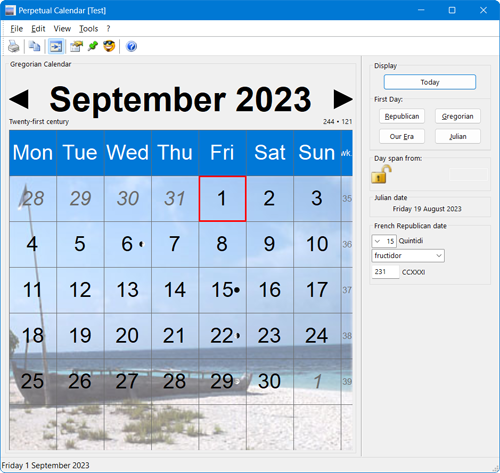Perpetual Calendar

Version 11.0
(November 2023)
Download CalendarSetup64.msi (64-bit)
Presentation
The Perpetual Calendar is a calendar programme pompously named 'perpetual', because it works from year -4712 to year 3999 of our era.
It shows :
- The dates, according to the Julian, Gregorian and French Republican calendars.
- The Julian dates may use historical or civil years (i.e. year starting on the first of January or on another day); Julian dates before our era optionally follow a 'proleptic' or 'historical' rule (see hereafter).
- Legal holidays (on a fixed date, related to Roman and Orthodox Easter, on a specific day of week - for instance, first Monday of month-, bank holidays, etc.) may be recorded for the country of your choice - public holidays for a set of countries are included; The legal holiday list is fully customizable and personal event (birthdays, etc.) may be added for date ranges.
- The moon phases.
- The day span between 2 dates.
The main window of the programme is made of two panes. The main part is the monthly calendar, always visible and an expandable right pane shows several information: the corresponding date in the Julian or Republican calendars. Several buttons position the active date : Today (the system date), to the beginning of the French Republican calendar (22nd of September 1792), the Gregorian calendar (default is 15th of October 1582), our era (first of January, year 1), or the beginning of the Julian calendar (first of January, year 45 before our era).
Calendars
The following explanations are limited to the elements used to develop this calendar programme.
The principle of the Julian calendar was adopted by Julius Caesar in the year 45 before our era (year 709 of Rome): It brings in the concept of a year of 365.25 days starting on the first of January. This calendar has lasted in Europe (with some changes in the structure and name of the months) until the Gregorian Reform.
At the beginning, the leap year were counted mistakenly every 3 years. To correct this error, Emperor Augustus decreed, in year 9 before our era (745 AUC), that the 12 years to come will count 365 days. From year 8 of our era, the cycle of leap years followed its normal course again.
Opinions differ about the fact that the first Julian year (-44) was a leap year and about the period of time when the leap years were suspended (from year 9 before our era to year 8 of our era, or from year 12 before our era to year 4 of our era). In this calendar, the 'historical' option considers year -44 as leap year, and suspends the leap year cycle from year 9 before our era (-8) to year 8 (i.e. year -8 is leap year, year +4 is not). The 'proleptic' mode simply applies the Julian theoretical calculation to past dates.
The Gregorian calendar has been adopted in Rome and several other
European countries in October 1582. The day after the 4 was the 15.
In France, the Gregorian calendar was adopted in December 1582. The
day following the 9 was the 20. In England, it was adopted in September
1752, the day after the 2 became the 14.
Each country has its own rules. You can change at will the first Gregorian
day in this calendar settings.
You may set year ranges for which years begin on another day than the first of January. For instance England used civil years starting on the 25 December, then the 25 March, before reverting to the 1 January in 1752.
The choice of 3999 (should have been 3268, but I am optimistic) as the End of Time is not related to any apocalyptic prophecy, but comes from the precision of the Gregorian calendar. Somewhere around this year, a correction of one day will be necessary to adjust to the solstice. As no official decision is taken yet, I preferred to play it safe.
The French Republican Calendar has been adopted in France on the 24th of October 1793. It was decreed that the 22nd of September 1792 was the first day of Year I (Primidi 1er vendémiaire an I). The Republican Calendar was abandoned on the first of January 1806. The Perpetual Calendar by default extends the Republican Date for any date after the 21st of September 1792.
To Install
Run the CalendarSetup64.msi file to launch the Windows Installer process.
A shortcut is added to the Desktop and an entry is added in the Programme Menu.
Note
The Perpetual Calendar is a freeware programme.
You may use it freely, as long as you accept the fact that is is proposed
"As Is", without any warranty of any kind.